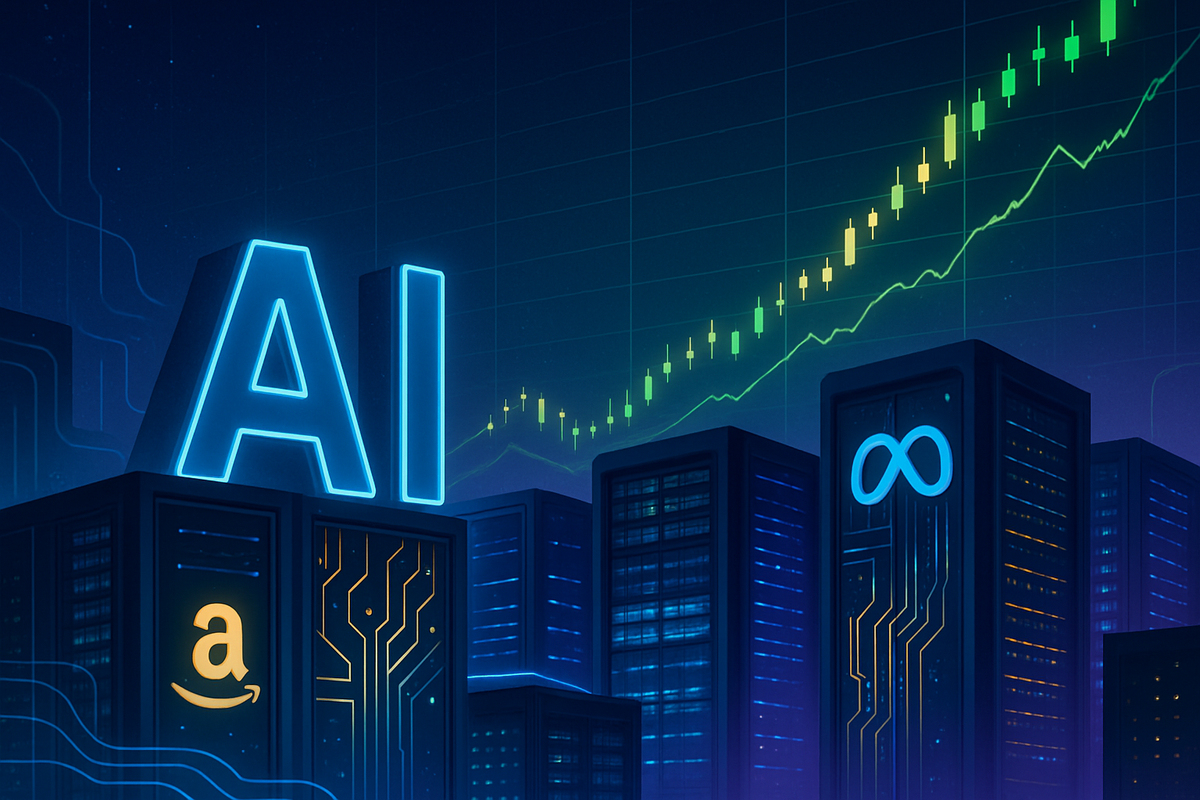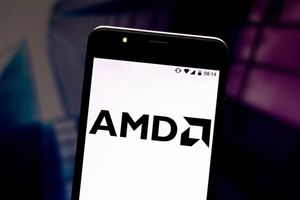
The financial markets are currently experiencing a significant uptrend, largely propelled by the colossal investments in Artificial Intelligence (AI) by tech behemoths Amazon (NASDAQ: AMZN) and Meta Platforms (NASDAQ: META). As of October 15, 2025, this aggressive push into AI infrastructure and development is not only showcasing the tech sector's remarkable resilience but also acting as a primary driving force behind the robust performance of the Nasdaq and the sustained ascent of the S&P 500. This "AI Gold Rush" signals a transformative era, where technological innovation directly translates into substantial market gains, yet also raises questions about market valuations and the long-term sustainability of this rapid growth.
These strategic investments by Amazon and Meta underscore a broader industry-wide conviction in AI's transformative power, positioning the tech sector at the forefront of global economic expansion. The billions being poured into generative AI, custom chips, and advanced data centers are not merely capital expenditures; they are foundational bets on the future of technology, productivity, and competitive advantage. This narrative of innovation and aggressive expansion continues to captivate investors, drawing significant capital inflows and reinforcing the tech sector's role as a resilient and powerful engine for market growth.
Unprecedented AI Commitments Drive Tech Sector Forward
Amazon and Meta are leading the charge in an unprecedented wave of AI investment, each adopting distinct yet equally ambitious strategies to dominate the burgeoning AI landscape. These commitments are not just substantial; they represent a fundamental reorientation of their business models towards an AI-first future.
Amazon is making a monumental commitment, planning to invest over $100 billion in capital expenditures in 2025, with the vast majority earmarked for AI initiatives within Amazon Web Services (AWS). CEO Andy Jassy has unequivocally stated that generative AI represents a "once-in-a-lifetime type of opportunity," reflecting the company's strategic focus. AWS's AI business is already a multi-billion dollar enterprise, boasting triple-digit percentage year-over-year growth. Beyond internal development, Amazon expanded its partnership with generative AI model developer Anthropic in November 2024, doubling its investment to $8 billion. The company is also a backer of Scale AI, a data labeling startup, participating in its 2024 funding round. Internally, Amazon leverages AI extensively across its retail and logistics operations, utilizing computer vision, demand forecasting, and robotic automation to enhance efficiency. Furthermore, AWS serves as critical infrastructure for numerous AI companies, providing essential computing and storage capabilities, while Amazon's Annapurna Labs subsidiary develops proprietary AI chips like Graviton CPUs and Trainium/Inferentia accelerators to offer cost-effective alternatives to third-party silicon.
Meta Platforms (NASDAQ: META) is embarking on an even more aggressive AI investment strategy, projecting capital expenditures of $60 billion to $65 billion in 2025 to bolster its AI infrastructure. This figure represents a significant increase from its estimated $38 billion to $40 billion expenditure in 2024. CEO Mark Zuckerberg's announcement underscores Meta's ambition to lead the AI race against competitors. Key elements of this investment include a substantial increase in AI-related hiring, the construction of data centers with over two gigawatts of capacity, and the goal of possessing more than 1.3 million graphics processors and 1 gigawatt of computing power by the end of 2025. Meta is also reportedly in discussions to invest over $10 billion in Scale AI, which would be its largest external AI investment to date. The company differentiates itself with an open-source approach to its Llama AI models, making them freely accessible. Meta's AI assistant, integrated across Facebook, Instagram, and WhatsApp, is anticipated to reach over 1 billion users by 2025, up from approximately 600 million monthly active users in 2024, and the company is also innovating with AI-powered Ray-Ban smart glasses.
These substantial AI investments are directly contributing to the remarkable resilience and growth observed in the tech sector, which in turn fuels the broader market's uptrend. As of October 15, 2025, the S&P 500 Information Technology sector is experiencing a robust surge, with year-to-date returns consistently hovering between 20% and 24% as of early October, acting as a primary catalyst for broader market gains. The Nasdaq and S&P 500 both closed higher on October 15, 2025, demonstrating market resilience. The "AI Gold Rush" has been identified as a primary catalyst, driving significant capital inflows into companies at the forefront of AI development and deployment. The tech sector showcased strong performance in 2024, largely due to standout results from semiconductor companies providing AI infrastructure, and is expected to maintain its strong position in 2025 and beyond.
Corporate Fortunes: Winners and Losers in the AI Race
The massive AI investments by Amazon and Meta are creating a clear delineation of winners and losers across various industries, profoundly reshaping competitive landscapes and market dynamics as of October 15, 2025. Companies directly involved in the AI infrastructure supply chain are poised for significant gains, while those unable to adapt risk losing market share.
On the winning side, semiconductor manufacturers are experiencing unprecedented demand. Companies like NVIDIA (NASDAQ: NVDA), Intel (NASDAQ: INTC), and AMD (NASDAQ: AMD) are seeing booming sales of high-performance GPUs and specialized AI accelerators, essential for powering the vast data centers Amazon and Meta are building. Memory providers such as Samsung (KRX: 005930), Micron (NASDAQ: MU), and SK Hynix (KRX: 000660) are also benefiting from the surge in demand for High-Bandwidth Memory (HBM). TSMC (NYSE: TSM), as the leading foundry for advanced chips, plays a crucial role in producing these components. Data center infrastructure and equipment providers are also thriving, as the expansion of AI-centric data centers drives demand for power systems, advanced cooling solutions, and high-bandwidth networking devices. Furthermore, power and utility companies are seeing a dramatic increase in electricity demand, forecasting a significant rise in capital expenditures (up 22% year-over-year to $212 billion in 2025 across 47 utilities) to meet the energy needs of these AI facilities.
Conversely, some sectors and companies face significant challenges. Traditional enterprise software companies that do not offer competitive AI-as-a-service solutions may lose market share to AWS's integrated AI offerings, such as its Bedrock platform. Amazon's heavy investment in robotics and AI for operational efficiency, particularly in fulfillment centers and potentially HR functions, could lead to a reduction in its overall corporate workforce in certain departments, impacting staffing and recruitment firms reliant on providing human labor to Amazon. For Meta, a potential shift away from its open-source Llama model strategy towards more proprietary AI (e.g., with its "Behemoth" model) could disadvantage smaller startups and independent researchers who rely on free, open-source foundation models, increasing barriers to entry and innovation. Additionally, Meta's advanced AI tools, such as the Andromeda recommendation engine, continuously refine its ad targeting and pricing, making its advertising platforms highly efficient. This intensifies competition in the digital advertising market, potentially challenging other ad-tech firms and platforms that cannot match Meta's sophisticated AI capabilities.
The impact extends to cloud infrastructure providers as well. While Amazon and Meta are building their own data centers, Meta's strategy of offering open-source AI models like Llama through partnerships with AWS (NASDAQ: AMZN), Google Cloud (NASDAQ: GOOGL), and Microsoft Azure (NASDAQ: MSFT) means these cloud providers benefit from hosting and distributing Meta's models. This complex interplay of competition and collaboration underscores the dynamic nature of the AI market, where strategic alliances and internal capabilities will dictate long-term success.
A New Industrial Revolution: Broader Significance of the AI Boom
The extensive AI investments by Amazon and Meta are not merely driving corporate profits and market uptrends; they are catalyzing a new industrial revolution, with profound wider significance across industries, regulatory landscapes, and historical precedents. As of October 2025, this era of rapid AI advancement is reshaping global economic structures and societal norms.
The current AI boom fits into broader industry trends marked by an intense "AI arms race" among tech giants. Amazon, Google (NASDAQ: GOOGL), Microsoft (NASDAQ: MSFT), and Meta are collectively projected to invest up to $320 billion in AI infrastructure in 2025, up from $230 billion in 2024. This massive capital flow is fueling an infrastructure boom, driving unprecedented demand for specialized AI chips, advanced data centers, and new energy infrastructure, including nuclear power, to support these energy-intensive operations. The ripple effects are evident in a transforming workforce, where AI is leading to significant automation and job reallocations. Amazon, for instance, is reportedly cutting 15% of its Human Resources division in 2025, reallocating resources towards AI and automation, and urging employees to develop AI skills to avoid redundancy.
The rapid advancement and widespread adoption of AI are also creating a complex and evolving regulatory landscape. AI has quickly become a mainstream enterprise risk, with 72% of S&P 500 companies disclosing at least one material AI risk in 2025, up from just 12% in 2023. Key regulatory concerns include reputational and ethical risks (biased outcomes, unsafe outputs), data privacy (new laws, data scraping lawsuits), cybersecurity (AI enabling sophisticated threats), and antitrust implications. The significant resources required for foundational AI development are leading to debates over whether the dominance of tech giants is an "engineering reality" or a path to monopolization. Warnings from the Bank of England and the IMF in October 2025 highlight concerns about financial stability and the need for oversight to prevent excessive speculation. The EU AI Act, with phased obligations beginning in 2025-2026, is a key piece of legislation creating strict requirements for high-risk AI systems.
Historically, the current AI investment boom draws parallels to the dot-com bubble of the late 1990s due to rapid technology spending growth, massive overinvestment, and inflated valuations. However, some argue that today's leading tech companies possess stronger fundamentals and more diversified revenue streams. Comparisons are also drawn to the railroad revolution of the 19th century and the Second Industrial Revolution, emphasizing AI's unprecedented transformative potential. The current bull market, which began in October 2022, aligns with historical patterns of tech investment cycles lasting approximately five years, suggesting potential for continued upside but also an elevated risk of correction in high-growth stocks. The industry is facing a crucial pivot from mere adoption and speculative investment to demonstrating clear, measurable returns on AI investments to avoid a bust.
The Road Ahead: Navigating AI's Future Trajectory
The future trajectory of the tech market, profoundly shaped by Amazon and Meta's AI investments, promises both unprecedented opportunities and significant challenges. As of October 15, 2025, the industry is poised for a "liftoff phase," where strategic pivots and adaptive measures will be crucial for sustained growth and market leadership.
In the short term (2025-2026), AI is expected to further permeate daily life and business operations, leading to increased automation and productivity. The rise of "agentic AI," capable of performing multi-step tasks with minimal human intervention, will gain traction, reshaping software platforms and delivering substantial returns on investment. The focus will shift from developing raw AI model performance to strategically deploying AI to generate tangible business value. Long-term possibilities (2027-2030 and beyond) envision a trillion-dollar global AI market, with the plausible development of Artificial General Intelligence (AGI) on the horizon. AI will profoundly reshape diverse industries, from healthcare to finance, and lead to a significant workforce transformation, creating new roles while displacing others, necessitating massive reskilling efforts.
Strategic pivots for companies will include a shift towards "AI-as-a-Service (AIaaS)," offering specialized AI-powered solutions, and the adoption of hybrid AI architectures where foundational model training remains centralized while inference increasingly shifts to edge devices. Market opportunities abound in niche AI solutions, AI infrastructure, and AI governance, which is projected to reach $1.4 billion by 2030. However, significant challenges persist, including regulatory complexity, data quality and bias, a persistent AI talent shortage, and the immense infrastructure demands (power and water consumption) of AI data centers. The market also faces potential volatility due to "stretched" valuations and concerns about an "AI bubble burst" similar to the dot-com era.
The AI Epoch: A Market Reassessment and Investor's Compass
The current epoch, defined by the monumental AI investments from Amazon and Meta, marks a fundamental reshaping of the technology landscape and global financial markets. As of October 15, 2025, the Nasdaq's sustained bounce and the S&P 500's robust uptrend are clear indicators of AI's immediate market impact, yet a comprehensive reassessment is vital for navigating the path forward.
Key takeaways from this period include Amazon's aggressive AI stance, with over $100 billion in 2025 capital expenditures focused on AWS AI and custom silicon, bolstering both cloud and advertising segments. Meta's deep dive into AI, with projected 2025 capital expenditures between $66 billion and $72 billion, aims to enhance advertising targeting and user engagement through sophisticated AI models and massive data center builds. Both the Nasdaq and S&P 500 have demonstrated strong performance, attributed to robust economic activity, healthy corporate earnings, and easing monetary policy. The S&P 500, in particular, has achieved more than 20% gains for two consecutive years (2023-2024), a phenomenon not seen since the late 1990s, underpinned by strong corporate earnings growth projected for 2024 and 2025.
Moving forward, the market's trajectory will be heavily influenced by the ongoing AI revolution, with the global AI computing market projected to reach $990 billion by 2027. Global IT spending is expected to grow by 9.3% in 2025, indicating continued expansion. However, the market faces potential headwinds from high valuations, geopolitical tensions, and policy uncertainties. There are growing concerns about an "AI stock market bubble," with some studies indicating that a significant percentage of organizations investing in generative AI are currently seeing zero returns. Despite these concerns, the lasting impact of these investments includes a massive build-out of cloud computing and data center infrastructure, essentially creating the foundational layer for the AI era, and a significant transformation of the labor market.
Investors in the coming months should closely monitor several key indicators. First, watch for clear evidence that AI investments are translating into sustained, tangible profits and improved return on investment, rather than just infrastructure build-out. Second, continue to track corporate earnings reports, particularly from the tech sector, for signs of sustained growth and any shifts in future guidance. Third, keep a close eye on interest rate policy and inflation trends, as unexpected shifts could introduce market headwinds. Fourth, the evolving geopolitical and regulatory landscape, including new U.S. presidential administration policies and increasing scrutiny on AI ethics and antitrust, will be crucial. Finally, given current high valuations, investors should be prepared for potential increased volatility and corrections, monitoring key support and resistance levels for major indices. Diversification across sectors, geographies, and asset classes can help mitigate risks in this rapidly evolving market. The AI epoch promises unprecedented innovation and growth, but prudent navigation will be key to long-term success.
This content is intended for informational purposes only and is not financial advice





